Featured Application
Resource and environmental effects of the Tibetan Plateau.
Abstract
Long-term stress accumulation influenced by coseismic stress changes and postseismic viscoelastic relaxation is considered critical to triggering giant earthquakes. Nevertheless, how the stress increase is interrupted by aftershocks and how it influences the megaseismic cycle remain enigmatic. In this study, based on the Mohr–Coulomb failure criterion at the nucleated segments of the 2008 great Sichuan earthquake, the stress variation associated with four M > 6 aftershocks was calculated for the period from 2010 to 2017. The results show that (1) the spatial distribution of coseismic stress change is correlated with the rupture pattern of large events and has a fundamental impact on triggering subsequent earthquakes and (2) postseismic viscoelastic relaxation leads to increased Coulomb stress accumulation at the northern and southern edges of the seismogenic Longmenshan fault, which results in enhanced fault instability and the potential for future large events.
1. Introduction
Sichuan and the adjacent region are the most seismically active parts of China, with complex geological and seismic tectonics within the North–South seismic zone [1,2,3]. Located on the eastern margin of the Tibetan Plateau, this region is affected by the process of India–Asia collision and abutment against the stable Yangtze Platform, causing strong compressional deformation, crustal shortening and thickening, and crustal extension from east to west [4,5,6]. There are several tectonic blocks and active faults, such as the Longmenshan fault, the Ganzi-Yushu fault, the Xianshuihe fault, and the eastern Kunlun fault (Figure 1). The Longmenshan fault on the eastern margin of the Tibetan Plateau is the result of the eastward compression of the South China block by the Bayan Har block [7]. It experienced intermittent tectonic deformation and formed the complex Longmenshan fold-and-thrust belt adjacent to the Sichuan foreland basin (Figure 1) [8,9,10]. During the Quaternary, the activity along the Longmenshan thrust belt was mainly concentrated on the Maoxian-Wenchuan and Jiangyou-Guanxian faults, as well as other faults with forward propagation deformation [11,12]. The Ganzi-Yushu fault zone can be traced for approximately 500 km along a strike and is composed of a series of fault segments, with a NW strike and left-lateral strike-slip behavior (Figure 1) [13,14,15]. The Xianshuihe fault zone is located within the Songpan-Ganze fold belt in the eastern part of the plateau [16]. The Xianshuihe fault extends 350 km northwest–southeast and is part of the 1400 km left-lateral system that passes through southern Yunnan Province, northwest through Sichuan Province into Qinghai Province (Figure 1). In planar view, the fault is a slightly convex arc, and its strike is almost parallel to those of other regional structures. At the northwestern end, the fault zone overlaps with the southeastern end of the Ganzi-Yushu fault, and the left en echelon step exceeds ~40 km. The southeastern end of the fault area is connected to the Zemuhe-Xiaojian fault. The Xianshuihe fault system consists of a series of faults that accommodate the clockwise rotation of crustal rocks between the South China block and the Eastern Himalayan syntaxis [17]. This area is one of the most seismogenically active areas in China, and the spatiotemporal variation in Coulomb stress remains enigmatic but is of considerable significance to regional earthquake risk evaluation. Therefore, in this study, we attempted to predict the stress evolution along fragile faults on the decadal time scale for the first time and to provide insights into earthquake risks in the Sichuan region.
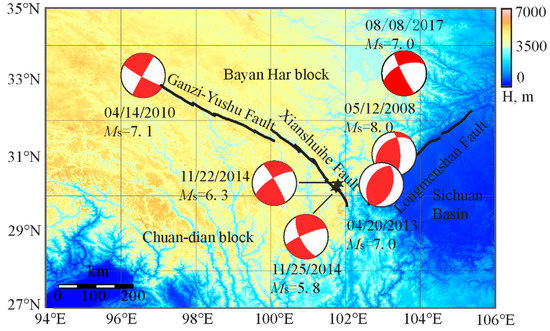
Figure 1.
Topographic map including the distribution of the 2008 Ms 8.0 great Sichuan (Wenchuan) earthquake and five other large earthquakes. The epicenter loci of the 2008 Wenchuan earthquake and 2013 Ms 7.0 Lushan earthquake are from the USGS, whereas the other epicenter loci (2010 Ms 7.1 Yushu earthquake, 2014 Ms 6.3 and Ms 5.8 Kangding earthquakes, and 2017 Ms 7.0 Jiuzhaigou earthquake) are from the China Earthquake Networks Center (CENC). The focal mechanisms of the Wenchuan and Lushan events are from the Global Centroid Moment Tensor (CMT), that of the Yushu event is from Liu et al. [18], those of the Ms 6.3 and Ms 5.8 Kangding double earthquakes are from Zhang et al. [19], and that of the Ms 7.0 Jiuzhaigou event is from the USGS.
Remarkable M > 6 earthquakes have repeatedly occurred in Sichuan every several years following the 2008 great Sichuan (Wenchuan) earthquake [6,20], including the 2010 Ms 7.1 Yushu earthquake, the 2013 Ms 7.0 Lushan earthquake, the 2014 Ms 6.3 and Ms 5.8 Kangding earthquakes, and the 2017 Ms 7.0 Jiuzhaigou earthquake. The 2013 Ms 7.0 Lushan earthquake and the 2008 Ms 8.0 Wenchuan earthquake occurred on the Longmenshan fault, the 2014 Ms 6.3 and Ms 5.8 Kangding earthquakes occurred along the Xianshuihe fault, and the 2010 Ms 7.1 Yushu earthquake ruptured the Ganzi-Yushu fault (Figure 1) [21]. The 2017 Ms 7.0 Jiuzhaigou earthquake was located on the Shuzheng fault, which is one of the branch faults of the eastern Kunlun fault zone [22,23]; this earthquake occurred approximately 9 years after the Wenchuan earthquake in 2008, and the epicenter was only tens of kilometers away from the northern section of the surface fracture zone of the 2008 great Sichuan (Wenchuan) earthquake.
Considering the high risk of large earthquakes in Sichuan in the near future, the evolution of the seismic mechanical mechanism in this area has become a hot spot for numerous studies (e.g., [24,25,26,27,28]). Multidisciplinary studies have explored the characteristics of these large regional earthquakes to improve seismic rupture forecasting and thus reduce earthquake disaster risk (e.g., [29,30,31]); these studies have focused on stress accumulation along fault systems as one of the main determining mechanisms and properties. The major factors causing the stress concentration in Sichuan are suggested to be the regional tectonic load of the India–Asia collision and the southward movement of the southeastern Tibetan Plateau relative to the South China block, as supported by the variation in tectonic stresses (e.g., [32,33]).
In addition, the authors of recent studies on stress transfer and fault interactions have proposed that previous large earthquakes may favor or advance subsequent earthquakes [34,35,36,37,38]. Considering that the stress redistribution induced by previous large earthquakes may change the properties of adjacent faults and promote fault rupture, such stress redistribution will ultimately lead to changes in seismicity [34,39,40,41]. Hence, the stress variations caused by large earthquakes might be another significant factor in adjusting the stress state of fault systems. The authors of relevant studies have used the Coulomb stress change in a pure elastic crust to quantify whether a fault rupture was advanced by a previous earthquake with a positive Coulomb stress change or delayed by one with a negative Coulomb stress change [37,42,43,44,45,46,47,48,49,50,51,52]. The Earth’s lower crust and mantle might deform as inelastic bodies, and the external stress relaxes with time (e.g., [53]). Therefore, the upper crust is elastic at the initial stage of stress loading and continues to deform due to stress relaxation.
Furthermore, because inelastic stress relaxation can also lead to a change in the stress distribution, it is necessary to consider inelastic behavior in the analysis of stress transfer and earthquake interaction. In addition, the postseismic stress changes caused by the viscous relaxation of the lower crust or upper mantle are also used to analyze the aftershock distribution, especially delayed triggered seismicity [36,49,54,55,56]. For example, Freed and Lin [36] pointed out that the 1999 M 7.1 Hector Mine earthquake in southern California might have been caused by the 1992 Landers earthquake (M = 7.3) through postearthquake stress changes within seven years after the Landers earthquake. Lorenzo-Martin et al. [56] analyzed a sequence of 10 magnitude Ms > 6.5 earthquakes from 1939 to 1999 and studied the evolution of the Coulomb stress field, including viscoelastic relaxation along the North Anatolian Fault; their results show that the Marmara Sea area is currently loading at the rate of Coulomb normal stress rather than due only to the stable tectonic load on the North Anatolian fault.
Accordingly, both elastic coseismic deformation and postearthquake viscoelastic relaxation have important impacts on the stress state around a fault system [54,57]. The areas of stress increase and stress decrease produced by coseismic dislocations occur alternately [39]. Thus, viscoelastic relaxation transfers the coseismic stress from the lower crust and upper mantle to the overlying seismogenic upper crust, resulting in a more complex regional stress distribution [36,57]. In this study, the evolution of stress is focused on the broad Sichuan area, which is the most seismically active region in China. The stress variation in this area were investigated for a period of more than 10 years since 2008, and the effects of coseismic stress changes and postseismic viscoelastic relaxations associated with large earthquakes in the past decade were examined. The main aim of the present study is to investigate the state of stress evolution in this region by considering the viscoelastic relaxation of the lower crust and upper mantle. The modeling technique and the parameters used in the calculation are carefully outlined. Then, the results of long-term stress evolution are obtained through the calculation of coseismic stress change and postseismic viscoelastic relaxation based on Coulomb failure stress change theory. Furthermore, the potential triggering mechanism and seismic risk of the fault system are discussed.
2. Method and Models
2.1. Coulomb Failure Stress Change
To analyze the stress evolution, the coseismic (static) and postseismic stress changes imparted by these earthquakes are calculated. The Coulomb failure stress change is expressed as (e.g., [37,38,39]), where is the change in normal stress, and is the change in shear stress calculated on a given receiving fault. μ′ is the effective friction coefficient. According to the Mohr–Coulomb failure criterion, failure is promoted by a positive Coulomb stress change and suppressed by a negative Coulomb failure stress change.
2.2. Model of the Lower Crust and the Upper Mantle
In this study, the coseismic (static) Coulomb stress changes (ΔCFS) caused by earthquake rupture [58,59] are calculated in an elastic half-space using a Poisson’s ratio of 0.25 and a friction coefficient μ′ = 0.6. Furthermore, to explore the stress evolution over time, a lithologic model is used in which the lower crust and the upper mantle are viscoelastic [49,55,56]. Thus, dislocation source models with the code PSGRN are used to calculate the Green’s function of the multilayered viscoelastic half-space [60].
The viscoelastic structure of the lithosphere is incorporated in the Tibetan Plateau, especially in its eastern boundary [61,62,63], and the data from geophysical inversion in the Longmenshan region are considered [64]. In this model, the crust and upper mantle are divided into 6 layers. Layers 1 and 2 represent the upper crust, consisting of two elastic layers. Layer 3 is the middle crust, which is a low-velocity layer [64,65]. Layers 3 to 6 are Maxwell viscoelastic bodies, and layer 3 is identified by geophysical inversion [64,65]. The layered model and other parameters used in the following calculations are listed in Table 1, where ρ is the density, VP is the P-wave velocity, VS is the S-wave velocity, H is the thickness, and η is the viscosity of each layer. The shear modulus is assumed to be 3.2 × 1010 Nm−2.

Table 1.
Model parameters.
2.3. Optimally Oriented Receiving Fault and Tectonic Stress Field
Two methods are usually used to calculate Coulomb failure stress changes. One approach is to calculate the stress changes on optimally oriented faults [39,52]. The change in Coulomb stress in the optimal orientation plane can be computed as the result of sliding along the main fault. Another approach is to calculate the stress change on faults with a specified orientation, which is derived from focal fault planes of subsequent earthquakes. However, it is assumed that there is a sufficient number of faults with all orientations and that the optimal direction of fault rupture is most likely to slip in subsequent earthquakes. Under a proposed regional stress state, the stress change is solved based on the optimal orientation plane. Based on the results of the tectonic stress tensor obtained by Du et al. [66], the parameters of the tectonic stress field in this area are shown in Table 2.

Table 2.
Tectonic stress field parameters.
2.4. Slip Source Model of Earthquakes
To calculate the stress evolution caused by these earthquakes since 2008, several variable slip source models are tested from different data sets by estimating the correlation between Coulomb stress changes and aftershocks. Figure 2 shows the slip distributions of these six models. Other parameters are listed in Table 3.
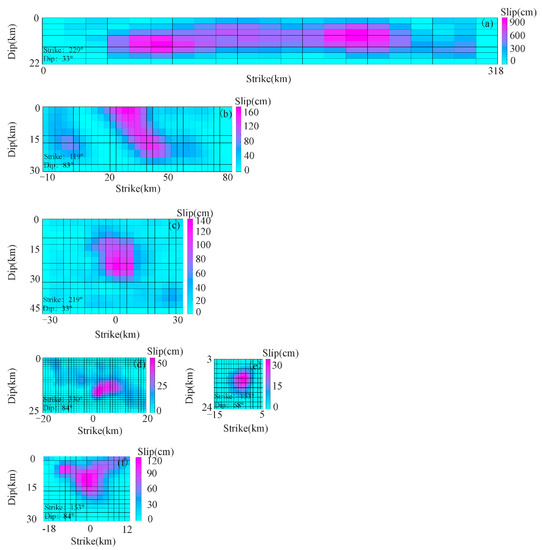
Figure 2.
Slip distributions for the source models of (a) the 2008 Ms 8.0 great Sichuan (Wenchuan) earthquake (http://www.geol.ucsb.edu/faculty/ji/big_earthquakes/2008/05/12/ShiChuan.html, accessed on 1 January 2016), (b) the 2010 Ms 7.1 Yushu earthquake [21], (c) the 2013 Ms 7.0 Lushan earthquake [67], (d) the 2014 Ms 6.3 Kangding earthquake [19], (e) the 2014 Ms 5.8 Kangding earthquake [19], and (f) the 2017 Ms 7.0 Jiuzhaigou earthquake [68].

Table 3.
Earthquake parameters for the six source models. The epicenters of the 2008 Ms 8.0 Wenchuan earthquake and the 2013 Ms 7.0 Lushan earthquake are from the USGS. The epicenters of the 2010 Ms 7.1 Yushu earthquake, the 2014 Ms 6.3, Ms 5.8 Kangding double earthquakes, and the 2017 Ms 7.0 Jiuzhaigou earthquake are from the China Earthquake Networks Center (CENC). Other parameters are from the source models shown in Figure 2.
Figure 2a shows the 2D slip model of the 2008 Ms 8.0 Wenchuan earthquake. The fault plane is set to a length of 318 km and a width of 22 km, with a strike of 229°, and it is discretized as a set of 168 patches (elements) with dimensions of 21 × 8 km2 (http://www.geol.ucsb.edu/faculty/ji/big_earthquakes/2008/05/12/ShiChuan.html, accessed on 1 January 2016). Figure 2b shows the 2D slip model of the 2010 Ms 7.1 Yushu earthquake. The fault plane is set to a length of 96 km and a width of 30 km, with a strike of 119°, and it is discretized as a set of 32 × 10 elements with dimensions of 3 × 3 km2 [21]. Figure 2c shows the 2D slip model of the 2013 Ms 7.0 Lushan earthquake. The fault plane is set to a length of 63 km and a width of 48 km, with a strike of 219°, and it is discretized as a set of 21 × 16 elements with dimensions of 3 × 3 km2 [67]. Figure 2d,e shows the 2D slip models of the 2014 Ms 6.3 and Ms 5.8 Kangding double earthquakes. In Figure 2d, the fault plane of the Ms 6.3 event is set to a length of 46 km and a width of 21 km, with a strike of 330°, and it is discretized as 46 × 21 elements with dimensions of 1 × 1 km2 [19]. In Figure 2e, the fault plane of the Ms 5.8 event is set to a length of 21 km and a width of 22 km, with a strike of 153°, and it is discretized as 21 × 22 elements with dimensions of 1 × 1 km2 [19]. Figure 2f shows the 2D slip model of the 2017 Ms 7.0 Jiuzhaigou earthquake. The fault plane is set to a length of 32 km and a width of 30 km, with a strike of 153°, and it is discretized as 16 × 15 elements with dimensions of 2 × 2 km2 [68]. The boundary condition of our 2D models generated using the finite element method (e.g., [69,70,71]) follows the multilayered viscoelastic half-space model setting (e.g., [60]).
3. Results
3.1. Coseismic Coulomb Stress Changes
Using the optimally oriented fault projection and the parameters shown in Table 2, the distribution of coseismic ΔCFS is calculated at the depths of the mainshock epicenters with the four largest aftershocks (Figure 3, Figure 4, Figure 5, Figure 6 and Figure 7). The coseismic stress changes caused by the Ms 6.3 and Ms 5.8 Kangding earthquakes in 2014 are calculated together and displayed on one map. In Figure 3, Figure 4, Figure 5, Figure 6 and Figure 7, the evolution of coseismic stress change is systematically tracked, and the triggering effects between the mainshocks and aftershocks are analyzed.

Figure 3.
(a) Distribution of coseismic Coulomb failure stress changes caused by the 2008 Ms 8.0 Wenchuan earthquake at the depth of the mainshock and aftershocks (Zhu et al. [72]). (b) Temporal distribution of the aftershock magnitudes. (c) Cumulative number of aftershocks over time.
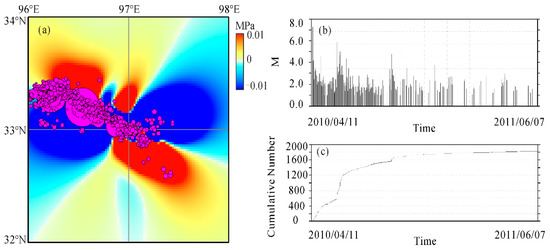
Figure 4.
(a) Distribution of coseismic Coulomb failure stress changes caused by the 2010 Ms 7.1 Yushu earthquake at the depth of the mainshock and aftershocks (Zhu et al. [73]). (b) Temporal distribution of aftershock magnitudes. (c) Cumulative number of aftershocks over time.
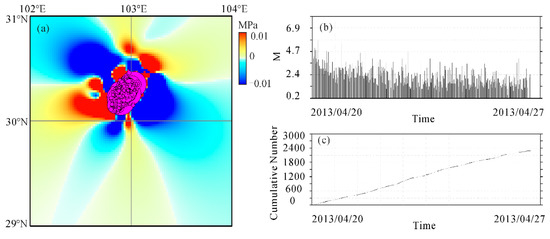
Figure 5.
(a) Distribution of coseismic Coulomb failure stress changes caused by the 2013 Ms 7.0 Lushan earthquake at the depth of the mainshock and aftershocks (Xu et al. [5]). (b) Temporal distribution of aftershock magnitudes. (c) Cumulative number of aftershocks over time.
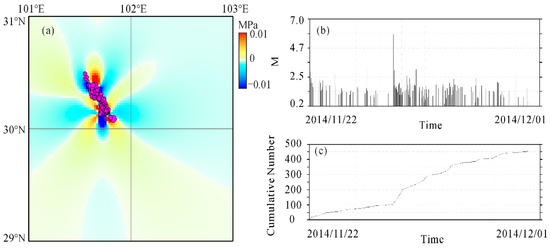
Figure 6.
(a) Distribution of coseismic Coulomb failure stress changes caused by the 2014 Ms 6.3 and Ms 5.8 Kangding double earthquakes at the depth of the mainshock and aftershocks (Yi et al. [74]). (b) Temporal distribution of aftershock magnitudes. (c) Cumulative number of aftershocks over time.
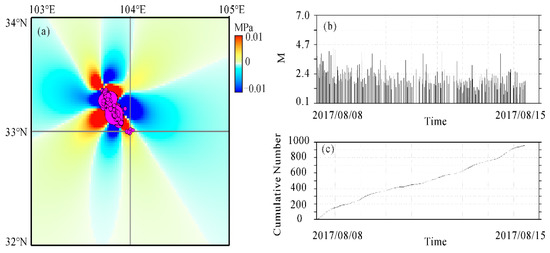
Figure 7.
(a) Distribution of coseismic Coulomb failure stress changes caused by the 2017 Ms 7.0 Jiuzhaigou earthquake at the depth of the mainshock and aftershocks (Yi et al. [22]). (b) Temporal distribution of aftershock magnitudes. (c) Cumulative number of aftershocks over time.
Figure 3a shows the coseismic ΔCFS pattern induced by the 2008 Wenchuan earthquake. In this figure, the positive lobes are adjacent to the northern and southern ends of the Wenchuan earthquake fault, reflecting the influence of Coulomb stress change (unclamping and clamping effects) and the expected large negative ΔCFS (“shadow”) areas surrounding the eastern and western sides of the fault. Due to the directionality of fault fracture, the areas in front of the fault slip direction are more likely to accumulate larger stress due to the pushing effect (positive lobes in Figure 3a). Figure 3a also shows the correlation between the stress change distribution and the subsequent earthquakes. Figure 3b,c shows the temporal distribution of aftershocks, indicating that the subsequent seismicity was obviously affected by the main earthquake. In the first month after the mainshock, many events occurred, primarily at sites along the ruptured fault, including some events with M ≥ 6.0. After more than a month, the frequency of aftershocks was still very high. We noted that only in the areas outside the main rupture, there is a relation between aftershocks and stress-enhanced areas (Figure 3a). In summary, Figure 3 suggests a potential correlation between most of the shocks distributed in areas with an increase in coseismic stress.
Similarly, Figure 4, Figure 5, Figure 6 and Figure 7 show the coseismic stress change field due to the 2010 Yushu earthquake, the 2013 Lushan earthquake, the two 2014 Kangding earthquakes, and the 2017 Ms 7.0 Jiuzhaigou earthquake. These figures also display the correlation between the stress change distribution and the aftershocks. The correlations between the ΔCFS and the aftershocks support the idea that the coseismic stress changes caused by the six earthquakes had a fundamental impact on the subsequent earthquakes in a short time following the main events.
3.2. Long-Term Evolution of Stress Changes
After a large earthquake, the changes in coseismic stress are further affected by the relaxation of the upper mantle and the viscous lower crust, which transfers the stress from these regions up to the middle crust and outward to a wider area. To quantify the potential stress changes on active faults in the study area, the cumulative changes in Coulomb stress are simulated after the six events (Figure 8). Figure 8 shows the stress changes caused by viscoelastic relaxation over the past 10+ years. The evolution of postseismic stress changes after earthquakes can be tracked systematically. The cumulative stress changes caused by these events show complex distributions. The simulated stress changes produce both positive and negative stresses on the source faults near these major events.
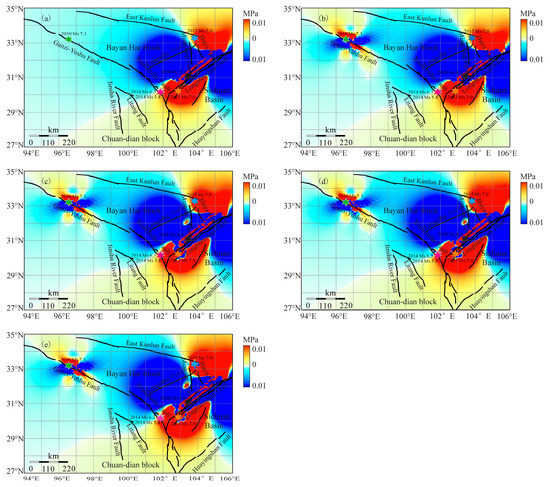
Figure 8.
Long-term evolution of stress changes induced by all the previous earthquakes with viscoelastic relaxation effects and resolved at the depths of the mainshocks with μ′ = 0.6: (a) immediately before the 2010 Ms 7.1 Yushu earthquake, (b) immediately after the 2010 Ms 7.1 Yushu earthquake, (c) immediately after the 2013 Ms 7.0 Lushan earthquake, (d) immediately after the 2014 Ms 5.8 Kangding earthquakes, and (e) stress changes calculated on 1 January 2020. The black star indicates the epicenter of the 2008 Ms 8.0 Wenchuan earthquake. The green star denotes the 2010 Ms 7.1 Yushu earthquake. The orange star represents the 2013 Ms 7.0 Lushan earthquake. The gray and pink stars indicate the 2014 Ms 6.3 and Ms 5.8 Kangding earthquakes, respectively. The blue star represents the 2017 Ms 7.0 Jiuzhaigou earthquake.
Immediately before the 2010 Yushu earthquake (Figure 8a), the positive and negative lobes of stress changes were similar to those previously observed (Figure 3a), but the positive and negative lobes were enlarged or reduced slightly around the 2008 Wenchuan ruptures. The slight change was that the average stress level increased due to nonuniform viscoelastic relaxation over two years. Immediately after the Yushu earthquake in 2010 (Figure 8b), the negative stress shadow of the Yushu earthquake enlarged the previous negative stress change in the middle of the study area. However, in the northwest, the Yushu earthquake caused a series of changes in the positive and negative stress lobes, although the changes in stress were not large enough to disturb the stress distribution in the eastern area controlled by the Wenchuan earthquake. The 2013 Lushan earthquake (Figure 8c) had just occurred, and the stress field in the southern part of the study area (~30° N) increased, forming a wider positive stress change area. The positive stress change zone also changed the stress in the southern section of the Xianshuihe fault. To the south of the Xianshuihe fault (~30° N), due to the Lushan event in 2013 and nonuniform viscoelastic relaxation, the change in positive stress was further expanded. After the two Kangding earthquakes (Figure 4d), the stress distribution in the southern segment of the Xianshuihe fault system (~30° N) changed slightly. The stress reduction areas on both sides of the Longmenshan fault were further strengthened. Those in the northern part of the study area (~34° N) also increased due to viscoelastic relaxation, forming a wide positive area.
The stress pattern in Figure 8 evolved as a result of postseismic relaxation of the lower crust and upper mantle. The postseismic relaxation effect leads to the increased ΔCFS near the northern and southern tips of the Longmenshan fault. At a distance of less than 300–400 km from the fault, the relaxation effect dominates because the shadow obviously extends outward. However, the relaxation effect tends to be reloaded near the fault zone.
Comparing the coseismic and postseismic stress changes reveals that the Wenchuan earthquake caused more coseismic stress changes than other earthquakes. That is, the stress field in the Sichuan and adjacent areas is dominated by stress changes imparted by the 2008 Ms 8.0 Wenchuan earthquake, which was the largest event in the past 10 years. Especially in southern Sichuan, where the Xianshuihe fault and Xiaojiang fault are located, Coulomb stress has increased. The Yushu earthquake in 2010 also resulted in an increase in stress zones in the northwestern part of the study area. The epicenters of the 2013 Lushan earthquake and the two 2014 Kangding earthquakes lie in the positive lobes of stress changes caused by the Wenchuan earthquake. The 2008 Wenchuan earthquake also significantly increased the northern area near the northern end of the Wenchuan focal plane, which could have generated a large earthquake (e.g., [75]). Coincidentally, the 2017 Ms 7.0 Jiuzhaigou earthquake occurred in this area. The 2008 Wenchuan earthquake and the 2010 Yushu earthquake also led to a stress shadow (region of Coulomb stress decrease), which may explain why few events have occurred on the western side of the Longmenshan fault.
As shown in Figure 8e, the state of the stress field in this area is affected by the six earthquakes. Some areas exhibit an increase in cumulative stress, and some exhibit a decrease in stress. Figure 8e also shows that the northern and southern parts of the Longmenshan fault zone are in the accumulation area of stress increases, so they might have the greatest seismic risk in the future.
3.3. Cumulative Stress Changes on Faults
Furthermore, the stress tensor was projected on each mainshock source fault, and the stress changes were calculated using the source fault parameters listed in Table 3. Table 4 lists the cumulative stress changes with the viscoelastic relaxation effect on each mainshock source fault. S1 indicates the stress changes induced by all the previous earthquakes. S2 refers to the stress changes caused by both previous earthquakes and this event with the viscoelastic relaxation effect. Table 4 implies that the stress accumulation before this earthquake played a role in increasing the stress of the earthquake and promoting the stress accumulation process in the focal area. However, after the large earthquake, the stress state in the focal area was basically unloaded by this main earthquake. The Yushu earthquake occurred far from the Longmenshan fault zone and was not obviously affected by the stress of the previous Wenchuan earthquake. Otherwise, because the Kangding Ms 5.8 earthquake occurred after the Kangding Ms 6.3 earthquake, tectonic stress might also accumulate to an adjacent degree; thus, even if a small part of the stress was unloaded in the focal area, the subsequent Ms 5.8 earthquake still occurred.

Table 4.
Stress changes due to cumulative coseismic slip and postseismic relaxation. S1 indicates the stress changes induced by all the previous earthquakes. S2 refers to the stress changes caused by previous earthquakes and this event. When calculating the stress, the receiving fault is the source fault of this main earthquake. Six input motions were selected for this table because the six events are the largest in the past decade in the Sichuan area after the Ms 8.0 Wenchuan earthquake in 2008.
The stress changes imposed on the active faults in the study area are shown in Figure 8. The northern and southern segments of the Longmenshan fault, the southern segment of the Xianshuihe fault, the east Kunlun fault, the northern segment of the Huya fault, and the Huayingshan fault are obviously affected by the stress increases caused by these mainshocks. Continuing forward in time, the postseismic stress change fields between 2013 (Figure 8c) and 2020 (Figure 8e) are slightly different. That is, after 2013, although western Sichuan was in a deep stress shadow, most of the northern and southern segments of the Longmenshan fault and Xianshuihe fault were in the stress concentration area. These results have certain reference significance for risk analysis associated with these earthquakes in the future.
4. Discussion
4.1. Earthquake Triggering in the Study Area
Sichuan and the adjacent western region are the most seismically active areas in China [76,77,78], and the geological structure and seismic structure are very complex. Therefore, the background seismicity in this area is high. To analyze the long-term rates of earthquakes, the catalog in the study area from 1 January 2000 to 1 January 2020 was provided by the China Earthquake Networks Center (CENC), which was divided into four subgroups with different cutoff magnitudes. Figure 9 and Figure 10 show that the seismicity in the study area is distributed over time.
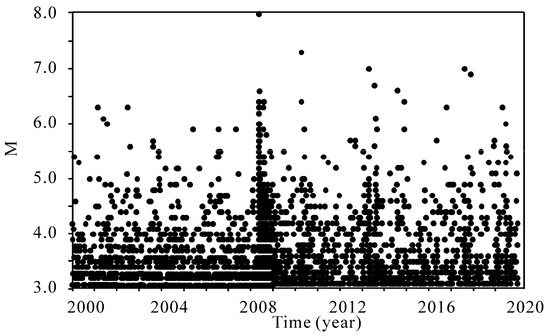
Figure 9.
Scatter plot of magnitude relative to the sequential number of events in this study area.
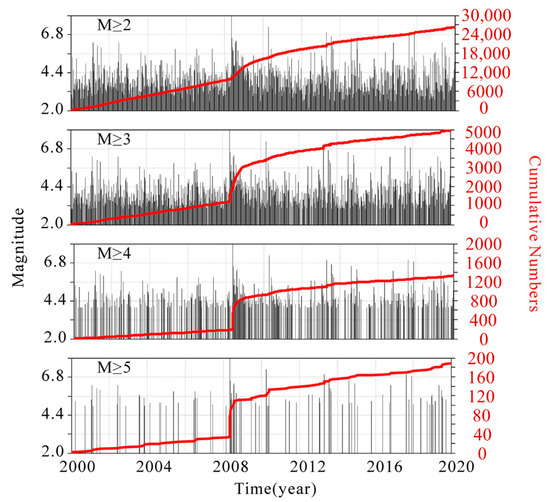
Figure 10.
Magnitude and cumulative numbers of seismic events in the study area from 2000 to 2020 using various cutoff magnitudes.
Figure 9 illustrates that before the Wenchuan earthquake in 2008, the seismicity in this area was relatively active, and there were few events with M ≥ 6. Since 2008, a dense seismic cluster has formed in the study area. After the Wenchuan earthquake in 2008, the seismicity in this area increased; more earthquakes with magnitudes of M ≥ 7 occurred than before, and seismicity with magnitudes of M ≥ 6 increased. Earthquakes with magnitudes of M ≥ 4 or M ≥ 5 also increased obviously. Until 2020, the seismicity trend remained high. In Figure 10, the sudden increase in M ≥ 2 earthquake activity was caused by the large number of Wenchuan earthquake aftershocks in 2008, after which the occurrence frequency gradually returned to a normal level. The rapid increase in the scale of M ≥ 4 and M ≥ 5 events in 2008 is more remarkable than that of M ≥ 2 events, indicating the change in faulting instability in this region (e.g., [79]).
4.2. Effect of Lower Crust or Mantle Rheological Properties on the Stress Evolution
In this section, the main factors that may lead to uncertainty in the numerical results are discussed. The uncertainty in stress change may be produced by all the uncertain parameters used in the stress calculation. The main influencing factors include the inhomogeneity of the crust, the use of a large source model, the viscosity, the locations of seismic events, and the regional stress state (e.g., [80,81,82]). In particular, our results may be affected by changes in viscosity. According to the study of deformation and rheological properties after earthquakes [23,62,63], a low viscosity in the lower crust is required by crustal flow beneath the Tibetan Plateau. Various methods are used to estimate the viscosity of the area, yielding values from 1016 to 1021 Pa·s. We assume that the mantle or lower crust has this viscosity range and test the range of stress variations to check the stability of the results. To test the effect of viscosity uncertainty, we change the viscosities of layers 3–6 of the model (Table 1) from 1016 to 1021 but maintain the original value in other layers. Considering that there various models use different combinations of viscosities for both the upper mantle and lower crust, only two models with maximum values and minimum values of viscosity are used to analyze the effect of stress changes (Table 5). Using these models, the stress changes on the Jiuzhaigou event induced by five previous earthquakes are calculated. Other parameters remain unchanged. The results are listed in Table 6. Furthermore, we also use the friction coefficients μ′ = 0.2, μ′ = 0.4 and μ′ = 0.6 to validate the stability of the results; these results are also listed in Table 6. The deviation in the stress change caused by different combinations of viscosities and friction coefficients is small and does not have a significant effect.

Table 5.
Models used to analyze the effect of different combinations of viscosities for both the upper mantle and lower crust. Model 1 is the original model used in this work. Model 2 has the maximum value of the viscosity combination. Model 3 has the minimum value of the viscosity combination.

Table 6.
Stress changes according to different models and different friction coefficients.
4.3. High Risk of Future Earthquakes with Moderate or Large Magnitude
Based on the Coulomb failure criterion, the failure state of the fault will be affected by changes in stress, and a positive change in stress will accelerate the stress loading of adjacent faults and promote subsequent earthquakes. In contrast, a negative change in stress delays or weakens the stress loading process of nearby faults [24,83].
In our study, both the coseismic Coulomb stress changes and the long-term stress evolution calculated in the study area indicate a potential correlation between the spatial distribution of aftershocks and the area of calculated stress increase. Our results show that the fault zones with the most significant stress increases are the northern and southern segments of the Longmenshan fault, the southern segment of the Xianshuihe fault, the east Kunlun fault, and the northern segment of the Huya fault, where large earthquakes might be triggered in the future. Moreover, the Coulomb stress has significantly increased in the southern zone and the northern area near the ends of the Wenchuan focal plane, which might indicate the possibility of a large earthquake.
5. Conclusions
In this study, the long-term stress evolution due to coseismic stress and postseismic viscoelastic relaxation is calculated based on the Mohr–Coulomb failure criterion in Sichuan Province and adjacent regions in China; the events studied are the 2008 Ms 8.0 Wenchuan earthquake, the 2010 Ms 7.1 Yushu earthquake, the 2013 Ms 7.0 Lushan earthquake, the 2014 Ms 6.3 and Ms 5.8 Kangding earthquakes, and the 2017 Ms 7.0 Jiuzhaigou earthquake. The stress changes due to viscoelastic relaxation over the past 10+ years are analyzed to systematically track the evolution of postseismic stress changes, as well as the potential earthquake hazard in the study area. The results show the following:
- (1)
- The spatial distribution of coseismic stress changes corresponds with the spatial pattern of aftershocks for these major events. The coseismic stress changes caused by these earthquakes have a fundamental triggering effect on subsequent earthquakes.
- (2)
- The postseismic relaxation effect leads to increased ΔCFS near the northern and southern edges of the Longmenshan fault. Comparing the coseismic and postseismic stress changes, the Wenchuan earthquake caused larger amounts of coseismic stress change than other earthquakes.
- (3)
- The northern and southern segments of the Longmenshan fault, the east Kunlun fault, the southern segment of the Xianshuihe fault, the northern segment of the Huya fault, and the Huayingshan fault are obviously affected by the stress increases caused by these mainshocks. In particular, the northern and southern Longmenshan fault zones are located in areas of increasing stress concentration and might be the areas with the greatest seismic risk in the future.
Author Contributions
C.X. designed the study, performed the modeling, and interpreted the results. C.X., Y.Z. and Y.J. wrote the manuscript. W.Z., R.Q., Y.X. and A.L. provided comments to improve the manuscript. All authors discussed the results and interpretations and participated in writing the paper. All authors have read and agreed to the published version of the manuscript.
Funding
This study was supported by the National Natural Science Foundation of China (Grant No. 41964001), the Second Tibetan Plateau Scientific Expedition and Research Program (2019QZKK0708), the State Key Laboratory of Earthquake Dynamics (Project No. LED2019B04), and the CAS Pioneer Hundred Talents Program.
Institutional Review Board Statement
Not applicable.
Informed Consent Statement
Not applicable.
Data Availability Statement
Data are available in the figures and tables or from the authors upon reasonable request.
Acknowledgments
We are grateful to Yong Zhang, Xu Zhang, Guixi Yi, and Ailan Zhu for their shared data and constructive comments. We thank Xinglin Lei from the Geological Survey of Japan for sharing the GeoTaos software used for the calculation and plotting in this study. We are also thankful to four anonymous reviewers for their constructive comments that allowed us to improve this manuscript.
Conflicts of Interest
All the authors listed certify that they have no involvement in any organization or entity with any financial interest (including honoraria; educational grants; participation in speakers’ membership, bureaus, consultancies, stock ownership, employment, or other equity interest; and patent-licensing arrangements or expert testimony) or nonfinancial interest (including professional or personal relationships, knowledge or beliefs, or affiliations) in the subject materials or matter discussed.
References
- Wang, E.Q.; Meng, Q.R. Mesozoic and Cenozoic tectonic evolution of the Longmenshan fault belt. Sci. China 2008, 52, 579–592. [Google Scholar] [CrossRef]
- Xu, X.W.; Wen, X.Z.; Chen, G.H.; Yu, G.H. Discovery of the Longriba fault zone in eastern Bayan Har block, China and its tectonic implication. Sci. China 2008, 51, 1209–1223. [Google Scholar] [CrossRef]
- Xu, X.; Wen, X.; Yu, G.; Chen, G.; Klinger, Y.; Hubbard, J.; Shaw, J. Coseismic reverse- and oblique-slip surface faulting generated by the 2008 Mw 7.9 Wenchuan earthquake, China. Geology 2009, 37, 515–518. [Google Scholar] [CrossRef]
- Xu, Z.Q.; Ji, S.C.; Li, H.B.; Hou, L.W.; Fu, X.F.; Cai, Z.W. Uplift of the Longmen Shan range and the Wenchuan earthquake. Episodes 2008, 31, 291–301. [Google Scholar] [CrossRef]
- Xu, X.; Wen, X.; Han, Z. Lushan Ms 7.0 earthquake: A blind reserve-fault earthquake. Chin. Sci. Bull. 2013, 58, 1887–1893. [Google Scholar] [CrossRef]
- Zhang, H.; Yi, G.; Zhang, P.; Kirby, E. On the evolution of seismogenic faults in the Longmen Shan, eastern Tibet. J. Asian Earth Sci. 2015, 111, 624–631. [Google Scholar] [CrossRef]
- Zhang, P.; Xu, X.; Wen, X.; Ran, Y. Slip rates and recurrence intervals of the Longmenshan active fault zone, and tectonic implications for the mechanism of the May 12 Wenchuan earthquake, 2008, Sichuan, China. Chin. J. Geophys. 2008, 51, 1066–1073, (In Chinese with English Abstract). [Google Scholar]
- Liu, S.G.; Luo, Z.L.; Zhao, X.K. Study on the dynamic mode and its simulation in the formation of Longmen Mountain-West Sichuan foreland basin system. Petrol. Geol. Exp. 2003, 25, 432–438, (In Chinese with English Abstract). [Google Scholar]
- Ullah, J.; Luo, M.; Ashraf, U.; Pan, H.P.; Anees, A.; Li, D.; Ali, M.; Ali, J. Evaluation of the geothermal parameters to decipher the thermal structure of the upper crust of the Longmenshan fault zone derived from borehole data. Geothermics 2022, 98, 102268. [Google Scholar] [CrossRef]
- Jiang, R.; Zhao, L.; Xu, A.Z.; Ashraf, U.; Yin, J.Q.; Song, H.; Su, N.; Du, B.Y.; Anees, A. Sweet spots prediction through fracture genesis using multi-scale geological and geophysical data in the karst reservoirs of Cambrian Longwangmiao Carbonate Formation, Moxi-Gaoshiti area in Sichuan Basin, South China. J. Pet. Explor. Prod. Technol. 2022, 12, 1313–1328. [Google Scholar] [CrossRef]
- Deng, Q.; Chen, S.; Zhao, X. Tectonics, seismicity and dynamics of Longmenshan Mountains and its adjacent regions. Seismol. Geol. 1994, 16, 389–403, (In Chinese with English Abstract). [Google Scholar]
- Ran, Y.; Chen, W.; Xu, X.; Chen, L.; Wang, H.; Li, Y. Late Quaternary paleoseismic behavior and rupture segmentation of the Yingxiu-Beichuan fault along the Longmen Shan fault zone, China. Tectonics 2014, 33, 2218–2232. [Google Scholar] [CrossRef]
- Shen, Z.K.; Lü, J.N.; Wang, M.; Bürgmann, R. Contemporary crustal deformation around the southeast borderland of the Tibetan Plateau. J. Geophys. Res. 2005, 110, B11409. [Google Scholar] [CrossRef]
- Peng, H.; Ma, X.M.; Bai, J.Q.; Du, D.P. Characteristics of quaternary activities of the Ganzê-Yushu fault zone. J. Geomech. 2006, 12, 295–304. [Google Scholar]
- Gan, W.J.; Zhang, P.Z.; Shen, Z.K.; Niu, Z.J.; Wang, M.; Wan, Y.G.; Zhou, D.M.; Cheng, J. Present-day crustal motion within the Tibetan Plateau inferred from GPS measurements. J. Geophys. Res. 2007, 121, B08416. [Google Scholar] [CrossRef]
- Xu, G.; Kamp, P.J.J. Tectonics and denudation adjacent to the Xianshuihe Fault, eastern Tibetan Plateau: Constraints from fission track thermochronology. J. Geophys. Res. 2000, 105, 19231–719251. [Google Scholar] [CrossRef]
- Wang, E.; Burchfiel, B.C.; Royden, L.H.; Chen, L.; Chen, J.; Li, W.; Chen, Z. Late Cenozoic Xianshuihe-Xiaojiang, Red River, and Dali Fault Systems of Southwestern Sichuan and Central Yunnan, China; Geological Society of America: Boulder, FL, USA, 1998; Volume 327, pp. 1–108. [Google Scholar] [CrossRef]
- Liu, C.; Xu, L.; Chen, Y. Quick moment tensor solution for 14 April 2010 Yushu, Qinghai, earthquake. Acta Seismol. Sin. 2010, 32, 366–368. [Google Scholar]
- Zhang, X.; Yan, C.; Xu, L.S. Analysis of the Love-waves for the rupture processes of the 2014 earthquake-doublet of Kangding, Sichuan. Chin. J. Geophys. 2016, 59, 2453–2467. (In Chinese) [Google Scholar] [CrossRef]
- Luo, Y.; Zhao, L.; Tian, J. Spatial and temporal variations of stress field in the Longmenshan Fault Zone after the 2008 Wenchuan, China earthquake. Tectonophysics 2019, 767, 228172. [Google Scholar] [CrossRef]
- Zhang, Y.; Xu, L.; Chen, Y. Source process of the 2010 Yushu, Qinghai, earthquake. Sci. China 2010, 53, 1249–1251. [Google Scholar] [CrossRef]
- Yi, G.; Long, F.; Liang, M.J.; Zhang, H.P.; Zhao, M.; Ye, Y.Q.; Zhang, Z.W.; Qi, Y.P.; Wang, S.W.; Gong, Y.; et al. Focal mechanism solutions and seismogenic structure of the 8 August 2017 M7.0 Jiuzhaigou earthquake and its aftershocks, northern Sichuan. Chin. J. Geophys. 2017, 60, 4083–4097. (In Chinese) [Google Scholar] [CrossRef]
- Liu, G.; Xiong, W.; Wang, Q.; Qiao, X.; Ding, K.; Li, X.; Yang, S. Source characteristics of the 2017 Ms 7.0 Jiuzhaigou, China, earthquake and implications for recent seismicity in eastern Tibet. J. Geophys. Res. 2019, 124, 4895–4915. [Google Scholar] [CrossRef]
- Xie, C.; Zhu, Y.; Lei, X.; Yu, H.; Hu, X. Pattern of stress change and its effect on seismicity rate caused by Ms 8.0 Wenchuan earthquake. Sci. China 2010, 53, 1260–1270. [Google Scholar] [CrossRef]
- Nalbant, S.S.; Mccloskey, J. Stress evolution before and after the 2008 Wenchuan, China earthquake. Earth Planet. Sci. Lett. 2011, 307, 222–232. [Google Scholar] [CrossRef]
- Zhao, G.Z.; Unsworth, M.J.; Zhan, Y.; Wang, L.F.; Zhang, J.H. Crustal structure and rheology of the Longmenshan and Wenchuan Mw 7.9 earthquake epicentral area from magnetotelluric data. Geology 2012, 40, 1139–1142. [Google Scholar] [CrossRef]
- Li, Y.; Jia, D.; Wang, M.; Shaw, J.H.; He, J.; Lin, A.; Xiong, L.; Rao, G. Structural geometery of the source region for the 2013 Mw 6.6 Lushan earthquake: Implication for earthquake hazard assessment along the Longmen Shan. Earth Planet. Sci. Lett. 2014, 390, 275–286. [Google Scholar] [CrossRef]
- Wang, Z.; Huang, R.; Pei, S. Crustal deformation along the Longmen-Shan fault zone and its implications for seismogenesis. Tectonophysics 2014, 610, 128–137. [Google Scholar] [CrossRef]
- Nalbant, S.; McCloskey, J.; Steacy, S.; NicBhloscaidh, M.; Murphy, S. Interseismic coupling, stress evolution, and earthquake slip on the Sunda megathrust. Geophys. Res. Lett. 2013, 40, 4204–4208. [Google Scholar] [CrossRef]
- Hauksson, E.; Meier, M.A.; Ross, Z.E.; Jones, L.M. Evolution of seismicity near the southernmost terminus of the San Andreas Fault: Implications of recent earthquake clusters for earthquake risk in southern California. Geophys. Res. Lett. 2017, 44, 1293–1301. [Google Scholar] [CrossRef]
- Hong, T.K.; Lee, J.; Kim, W.; Hahm, I.K.; Woo, N.C.; Park, S. The 12 September 2016 ML5.8 midcrustal earthquake in the Korean Peninsula and its seismic implications. Geophys. Res. Lett. 2017, 44, 3131–3138. [Google Scholar] [CrossRef]
- Wang, Q.; Zhang, P.; Freymueller, J.T.; Bilham, R.; Larson, K.M.; Lai, X.; You, X.; Niu, Z.; Wu, J.; Li, Y.; et al. Present-day crustal deformation in China constrained by global positioning system measurements. Science 2001, 294, 574–577. [Google Scholar] [CrossRef] [PubMed]
- Zhang, P.; Shen, Z.; Wang, M.; Gan, W.; Bürgmann, R.; Molnar, P.; Wang, Q.; Niu, Z.; Sun, J.; Wu, J.; et al. Continuous deformation of the Tibetan plateau from global positioning system data. Geology 2004, 32, 809–812. [Google Scholar] [CrossRef]
- Harris, R.A. Introduction to special section: Stress triggers, stress shadows, and implications for seismic hazard. J. Geophys. Res. 1998, 103, 24347–24358. [Google Scholar] [CrossRef]
- Stein, R.S. The role of stress transfer in earthquake occurrence. Nature 1999, 402, 605–609. [Google Scholar] [CrossRef]
- Freed, A.M.; Lin, J. Delayed triggering of the 1999 Hector Mine earthquake by viscoelastic stress transfer. Nature 2001, 411, 180–183. [Google Scholar] [CrossRef] [PubMed]
- Toda, S.; Stein, R.S. Response of the San Andreas fault to the 1983 Coalinga-Nuñez earthquakes: An application of interaction-based probabilities for Parkfield. J. Geophys. Res. 2002, 107, 2126. [Google Scholar] [CrossRef]
- Toda, S.; Stein, R.S. Toggling of seismicity by the 1997 Kagoshima earthquake couplet: A demonstration of time-dependent stress transfer. J. Geophys. Res. 2003, 108, 2567. [Google Scholar] [CrossRef]
- King, G.C.P.; Stein, R.S.; Lin, J. Static stress changes and the triggering of earthquakes. Bull. Seismol. Soc. Am. 1994, 84, 935–953. [Google Scholar]
- Gomberg, J.; Beeler, N.M.; Blanpied, M.L. Earthquake triggering by transient and static deformations. J. Geophys. Res. 1998, 103, 24411–24426. [Google Scholar] [CrossRef]
- Kilb, D.; Gomberg, J.; Bodin, P. Aftershock triggering by complete Coulomb stress changes. J. Geophys. Res. 2002, 107. [Google Scholar] [CrossRef]
- Reasenberg, P.A.; Simpson, R.W. Response of regional seismicity to the static stress change Produced by the Loma Prieta earthquake. Science 1992, 255, 1687–1690. [Google Scholar] [CrossRef] [PubMed]
- Stein, R.S.; King, G.C.P.; Lin, J. Change in failure stress on the southern San Andreas fault system caused by the 1992 Magnitude = 7.4 Landers earthquake. Science 1992, 258, 1328–1332. [Google Scholar] [CrossRef] [PubMed]
- Stein, R.S.; King, G.C.P.; Lin, J. Stress triggering of the 1994 M = 6.7 Northridge, California, earthquake by its predecessors. Science 1994, 265, 1432–1435. [Google Scholar] [CrossRef]
- Stein, R.S.; Barka, A.A.; Dieterich, J.H. Progressive failure on the North Anatolian fault since 1939 by earthquake stress triggering. Geophys. J. Int. 1997, 128, 594–604. [Google Scholar] [CrossRef]
- Caskey, S.J.; Wesnousky, S.G. Static stress changes and earthquake triggering during the 1954 Fairview Peak and Dixie Valley earthquakes, central Nevada. Bull. Seismol. Soc. Am. 1997, 87, 521–527. [Google Scholar] [CrossRef]
- Anderson, G.; Johnson, H. A new statistical test for static stress triggering: Application to the 1987 Superstition Hills earthquake sequence. J. Geophys. Res. 1999, 104, 20153–20168. [Google Scholar] [CrossRef]
- Felzer, K.R.; Becker, T.W.; Abercrombie, R.E.; Ekstrom, G.; Rice, J.R. Triggering of the 1999 MW 7.1 Hector Mine earthquake by aftershocks of the 1992 MW 7.3 Landers earthquake. J. Geophys. Res. 2001, 107, 2109. [Google Scholar] [CrossRef]
- Pollitz, F.F.; Sacks, I.S. Stress triggering of the 1999 Hector Mine earthquake by transient deformation following the 1992 Landers Earthquake. Bull. Seismol. Soc. Am. 2002, 92, 1487–1496. [Google Scholar] [CrossRef]
- Marsan, D. Triggering of seismicity at short timescales following California earthquakes. J. Geophys. Res. 2003, 108, 2266. [Google Scholar] [CrossRef]
- Catalli, F.; Cocco, M.; Console, R.; Chiaraluce, L. Modeling seismicity rate changes during the 1997 Umbria-Marche sequence (central Italy) through a rate- and state-dependent model. J. Geophys. Res. 2008, 113, B11301. [Google Scholar] [CrossRef]
- Toda, S.; Lin, J.; Meghraoui, M.; Stein, R.S. 12 May 2008 M = 7.9 Wenchuan, China, earthquake calculated to increase failure stress and seismicity rate on three major fault systems. Geophys. Res. Lett. 2008, 35, L17305. [Google Scholar] [CrossRef]
- Thatcher, W.; Rundle, J.R. A viscoelastic coupling model for the cyclic deformation due to periodically repeated earthquakes at subduction zones. J. Geophys. Res. 1984, 89, 7631–7640. [Google Scholar] [CrossRef]
- Deng, J.; Hudnut, K.; Gurnis, M.; Hauksson, E. Stress loading from viscous flow in the lower crust and triggering of aftershocks following the 1994 Northridge, California, earthquake. Geophys. Res. Lett. 1999, 26, 3209–3212. [Google Scholar] [CrossRef]
- Zeng, Y. Viscoelastic stress-triggering of the 1999 Hector Mine earthquake by the 1992 Landers earthquake. Geophys. Res. Lett. 2001, 28, 3007–3010. [Google Scholar] [CrossRef]
- Lorenzo-Martin, F.; Roth, F.; Wang, R.J. Elastic and inelastic triggering of earthquakes in the North Anatolian Fault zone. Tectonophysics 2006, 424, 271–289. [Google Scholar] [CrossRef]
- Freed, A.M.; Bürgmann, R.; Calais, E.; Freymueller, J.; Hreinsdóttir, S. Implications of deformation following the 2002 Denali, Alaska,earthquake for postseismic relaxation processes and lithospheric rheology. J. Geophys. Res. 2006, 111, B01401. [Google Scholar] [CrossRef]
- Okada, Y. Internal deformation due to shear and tensile faults in a halfspace. Bull. Seismol. Soc. Am. 1992, 82, 1018–1040. [Google Scholar] [CrossRef]
- Riaz, M.S.; Bin, S.; Naeem, S.; Kai, W.; Xie, Z.J.; Gilani, S.M.M.; Ashraf, U. Over 100 years of faults interaction, stress accumulation, and creeping implications, on Chaman Fault System, Pakistan. Int. J. Earth Sci. 2019, 108, 1351–1359. [Google Scholar] [CrossRef]
- Wang, R.; Lorenzo-Martín, F.; Roth, F. PSGRN/PSCMP—A new code for calculating co- and post-seismic deformation, geoid and gravity changes based on the viscoelastic-gravitational dislocation theory. Comput. Geosci. 2006, 32, 527–541. [Google Scholar] [CrossRef]
- Johnson, K.M.; Hilley, G.E.; Burgmann, R. Influence of lithosphere viscosity structure on estimates of fault slip rate in the Mojave region of the San Andreas fault system. J. Geophys. Res. 2007, 112, B07408. [Google Scholar] [CrossRef]
- Diao, F.; Xiong, X.; Wang, R. Mechanisms of Transient Postseismic Deformation Following the 2001 Mw 7.8 Kunlun (China) Earthquake. Pure Appl. Geophys. 2010, 168, 767–779. [Google Scholar] [CrossRef]
- Ryder, R.B.; Pollitz, F. Lower crustal relaxation beneath the Tibetan Plateau and Qaidam Basin following the 2001 Kokoxili earthquake. Geophys. J. Int. 2011, 187, 613–630. [Google Scholar] [CrossRef]
- Liu, Q.; Li, Y.; Chen, J.; Guo, B.; Li, S.; Wang, J.; Zhang, X.; Qi, S. Wenchuan M 8.0 earthquake: Preliminary study of the S-wave velocity structure of the crust and upper mantle. Chin. J. Geophys. 2009, 52, 309–319. (In Chinese) [Google Scholar]
- Zhang, Z.; Yuan, X.; Chen, Y.; Tian, X.; Kind, R.; Li, X.; Teng, J. Seismic signature of the collision between the east Tibetan escape flow and the Sichuan Basin. Earth Planet. Sci. Lett. 2010, 292, 254–264. [Google Scholar] [CrossRef]
- Du, Y.; Xie, F.R.; Zhang, X.L.; Jing, Z.J. The mechanics of fault slip of Ms 8.0 Wenchuan earthquake. Chin. J. Geophys. 2009, 52, 464–473, (In Chinese with English Abstract). [Google Scholar]
- Zhang, Y.; Xu, L.S.; Chen, Y.T. Rupture process of the Lushan 4.20 earthquake and preliminary analysis on the disaster—Causing mechanism. Chin. J. Geophys. 2013, 56, 1408–1411. (In Chinese) [Google Scholar] [CrossRef]
- Zhang, X.; Feng, W.; Xu, L.; Li, C. The source-process inversion and the intensity estimation of the 2017 Ms 7.0 Jiuzhaigou earthquake. Chin. J. Geophys. 2017, 60, 4105–4116. (In Chinese) [Google Scholar] [CrossRef]
- Coleman, J.L.; Bolisetti, C.; Whittaker, A.S. Time-domain soil-structure interaction analysis of nuclear facilities. Nucl. Eng. Des. 2016, 298, 264–270. [Google Scholar] [CrossRef]
- Forcellini, D. 3D Numerical simulations of elastomeric bearings for bridges. Innov. Infrastruct. Solut. 2016, 1, 45. [Google Scholar] [CrossRef]
- Su, L.; Lu, J.; Elgamal, A.; Arulmoli, A.K. Seismic performance of a pile-supported wharf: Three dimensional finite element simulation. Soil Dyn. Earthq. Eng. 2017, 95, 167–179. [Google Scholar] [CrossRef]
- Zhu, A.; Xu, X.; Diao, G.; Su, J.; Feng, X.; Sun, Q.; Wang, Y. Relocation of the Ms 8.0 Wenchuan earthquake sequence in part: Preliminary seismotectonic analysis. Seismol. Geol. 2008, 30, 759–767, (In Chinese with English Abstract). [Google Scholar]
- Zhu, A.; Xu, X.; Yu, G.; Zhang, X.; Chen, G.; Ren, Y. Relocation of the Yushu Ms 7.1 earthquake sequence and investigation on its seismotectonics. Earth Sci. Front. 2012, 19, 8–14, (In Chinese with English Abstract). [Google Scholar]
- Yi, G.; Long, F.; Wen, X.; Liang, M.; Wang, S. Seismogenic structure of the M6.3 Kangding earthquake sequence on 22 Nov. 2014, Southwestern China. Chin. J. Geophys. 2015, 58, 1205–1219. (In Chinese) [Google Scholar] [CrossRef]
- Hu, J.; Fu, L.; Sun, W.; Zhang, Y. A study of the Coulomb stress and seismicity rate changes induced by the 2008 Mw 7.9 Wenchuan earthquake, SW China. J. Asian Earth Sci. 2017, 135, 303–319. [Google Scholar] [CrossRef]
- Han, W.; Jiang, G. Study on distribution characteristics of strong earthquakes in Sichuan-Yunnan area and their geological tectonic background. Acta Seismol. Sin. 2004, 17, 230–243. [Google Scholar]
- Liu, X.; Ma, J.; Du, X.; Zhu, S.; Li, L.; Sun, D. Recent movement changes of main fault zones in the Sichuan-Yunnan region and their relevance to seismic activity. Sci. China Earth Sci. 2016, 59, 1267–1282. [Google Scholar] [CrossRef]
- Wu, W.; Wu, P.; Wei, Y.; Sun, W. Regional Characteristics of Stress State of Main Seismic Active Faults in Mid-Northern Part of Sichuan-Yunnan Block. Chin. J. Geophys. 2017, 60, 254–265. [Google Scholar]
- Huang, Q. Seismicity changes prior to the Ms 8.0 Wenchuan earthquake in Sichuan, China. Geophys. Res. Lett. 2008, 35. [Google Scholar] [CrossRef]
- Shao, Z.G.; Fu, R.S.; Xue, T.X.; Huang, J.H. Numerical simulation and discussion on the mechanism of postseismic deformation after Kunlun Ms 8.1 earthquake. Chin. J. Geophys. 2008, 51, 584–596. [Google Scholar] [CrossRef]
- Li, Y.; Liu, S.; Chen, L.; Du, Y.; Li, H.; Liu, D. Mechanism of crustal deformation in the Sichuan-Yunnan region, southeastern Tibetan Plateau: Insights from numerical modeling. J. Asian Earth Sci. 2017, 146, 142–151. [Google Scholar] [CrossRef]
- Liao, L.; Li, P.E.; Yang, J.S.; Liu, P.; Feng, J.Z. The stress evolution before the 2013 M7.0 Lushan earthquake in the Longmen Shan area since 1900. J. Geodyn. 2019, 125, 1–12. [Google Scholar] [CrossRef]
- Freed, A.M. Earthquake triggering by static, dynamic, and postseismic stress transfer. Annu. Rev. Earth Planet. Sci. 2005, 33, 335–367. [Google Scholar] [CrossRef]
Publisher’s Note: MDPI stays neutral with regard to jurisdictional claims in published maps and institutional affiliations. |
© 2022 by the authors. Licensee MDPI, Basel, Switzerland. This article is an open access article distributed under the terms and conditions of the Creative Commons Attribution (CC BY) license (https://creativecommons.org/licenses/by/4.0/).